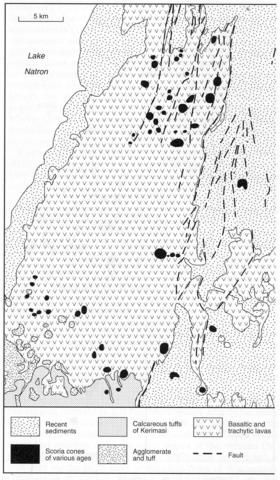stripes
This large volcano extends over 45 km north-south and is located on the eastern down-warped flank of the Gregory Rift valley. It rises to about 3000 m and on the eastern, and particularly northern, sides is heavily faulted into horsts and grabens. There are numerous parasitic cones and craters on the lower southern slopes. Olivine basaltic lavas are the principal component but in places these pass into basanite. Trachyte is generally confined to the summit area, but also forms a small cone on the northwest side, and there are extensive trachytes in the block-faulted country north of Gelai, but these were probably not erupted from the Gelai centre but are a southerly continuation of the trachytes of the Magadi area of Kenya to the north. The trachytes are flow-banded rocks with microphenocrysts of sanidine in a groundmass of sanidine, aegirine-augite, riebeckite and opaque minerals; a barkevikitic amphibole is sometimes present. Phonolites have also been recorded. Chemical and mineralogical data for two basanites are given by Paslick et al. (1996).
EVANS, A.L., FAIRHEAD, J.D. and MITCHELL, J.G. 1971. Potassium-argon ages from the volcanic province of northern Tanzania. Nature, Physical Science, 229: 19-20.
GUEST, N.J. and PICKERING, R. 1966a. Kibangaini. Mineral Resources Division, Tanzania, Quarter Degree Sheet, 28.
GUEST, N.J. and PICKERING, R. 1966b. Gelai and Ketumbeine. Mineral Resources Division, Tanzania, Quarter Degree Sheet, 40.
PASLICK, C., HALLIDAY, A.N., JAMES, D. and DAWSON, J.B. 1996. Indirect crustal contamination: evidence from isotopic and chemical disequilibrium in minerals from alkali basalts and nephelinites from northern Tanzania. Contributions to Mineralogy and Petrology, 125: 277-92.

